Pavement Quality Evaluation Using Connected Vehicle Data
Abstract
:1. Introduction
2. Motivation
3. Objectives
4. Data Collection Equipment and Methods
- a calibrated inertial profiler;
- a single production vehicle; and
- GoPro cameras for pavement roughness validation.
5. Single Production Vehicle Pavement Roughness Data vs. Inertial Profiler
6. Crowd-Sourced Pavement Roughness Data vs. Inertial Profiler
7. Results and Discussion
7.1. Prioritizing Maintenance
7.2. Pavement Improvement Evaluation after Reconstruction
7.3. Network Level Pavement Quality Assessment
8. Conclusions and Future Scope
Author Contributions
Funding
Institutional Review Board Statement
Informed Consent Statement
Data Availability Statement
Acknowledgments
Conflicts of Interest
References
- Transportation Energy Data Book. US Department of Energy. 2022. Available online: https://tedb.ornl.gov/wp-content/uploads/2022/03/TEDB_Ed_40.pdf#page=79 (accessed on 5 May 2022).
- Reauthorizing Federal Highway Programs: Issues and Options. Congressional Budget Office. Available online: https://www.cbo.gov/publication/56373 (accessed on 17 June 2022).
- Fact Sheet: The Bipartisan Infrastructure Deal. The White House. Available online: https://www.whitehouse.gov/briefing-room/statements-releases/2021/11/06/fact-sheet-the-bipartisan-infrastructure-deal/ (accessed on 17 June 2022).
- Our Nation’s Highways. US Department of Transportation. 2000. Available online: https://www.fhwa.dot.gov/ohim/onh00/our_ntns_hwys.pdf (accessed on 17 June 2022).
- Our Nation’s Highways: 2011. Federal Highway Administration. Available online: https://www.fhwa.dot.gov/policyinformation/pubs/hf/pl11028/chapter1.cfm (accessed on 17 June 2022).
- Logan, A. Crowdsourcing Data on Road Quality and Excess Fuel Consumption. Massachusetts Institute of Technology News. Available online: https://news.mit.edu/2021/crowdsourcing-road-quality-and-excess-fuel-consumption-0514 (accessed on 7 July 2022).
- Pierce, L.M.; McGovern, G.; Zimmerman, K.A. Practical Guide for Quality Management of Pavement Condition Data Collection. 2013; p. 170. Available online: https://www.fhwa.dot.gov/pavement/management/qm/data_qm_guide.pdf (accessed on 7 July 2022).
- Okine, A.; Adarkwa, O. Pavement Condition Surveys—Overview of Current Practices. Del. Cent. Transp. 2013, 19716, 1–71. Available online: https://cpb-us-w2.wpmucdn.com/sites.udel.edu/dist/1/1139/files/2013/10/Rpt-245-Pavement-Condition-Okine-DCTR422232-1pzk0uz.pdf (accessed on 7 July 2022).
- Seraj, F.; van der Zwaag, B.J.; Dilo, A.; Luarasi, T.; Havinga, P. RoADS: A Road Pavement Monitoring System for Anomaly Detection Using Smart Phones. In Big Data Analytics in the Social and Ubiquitous Context; Springer: Berlin/Heidelberg, Germany, 2016; pp. 128–146. [Google Scholar] [CrossRef] [Green Version]
- Buttlar, W.G.; Islam, M.S. Integration of Smart-Phone-Based Pavement Roughness Data Collection Tool with Asset Management System. 2014. Available online: https://www.researchgate.net/publication/272355273_Integration_of_Smart-Phone-Based_Pavement_Roughness_Data_Collection_Tool_with_Asset_Management_System (accessed on 22 June 2022).
- Kamranfar, P.; Lattanzi, D.; Shehu, A.; Stoffels, S. Pavement Distress Recognition via Wavelet-Based Clustering of Smartphone Accelerometer Data. J. Comput. Civ. Eng. 2022, 36, 04022007. [Google Scholar] [CrossRef]
- Mahmoudzadeh, A.; Golroo, A.; Jahanshahi, M.R.; Yeganeh, S.F. Estimating Pavement Roughness by Fusing Color and Depth Data Obtained from an Inexpensive RGB-D Sensor. Sensors 2019, 19, 1655. [Google Scholar] [CrossRef] [Green Version]
- Baek, J.-W.; Chung, K. Pothole Classification Model Using Edge Detection in Road Image. Appl. Sci. 2020, 10, 6662. [Google Scholar] [CrossRef]
- Fan, R.; Wang, H.; Wang, Y.; Liu, M.; Pitas, I. Graph Attention Layer Evolves Semantic Segmentation for Road Pothole Detection: A Benchmark and Algorithms. IEEE Trans. Image Process. 2021, 30, 8144–8154. [Google Scholar] [CrossRef] [PubMed]
- Ryu, S.-K.; Kim, T.; Kim, Y.-R. Image-Based Pothole Detection System for ITS Service and Road Management System. Math. Probl. Eng. 2015, 2015, 968361. [Google Scholar] [CrossRef] [Green Version]
- Tedeschi, A.; Benedetto, F. A real-time automatic pavement crack and pothole recognition system for mobile Android-based devices. Adv. Eng. Inform. 2017, 32, 11–25. [Google Scholar] [CrossRef]
- Koch, C.; Brilakis, I. Pothole detection in asphalt pavement images. Adv. Eng. Inform. 2011, 25, 507–515. [Google Scholar] [CrossRef]
- Feng, Z.; El Issaoui, A.; Lehtomäki, M.; Ingman, M.; Kaartinen, H.; Kukko, A.; Savela, J.; Hyyppä, H.; Hyyppä, J. Pavement distress detection using terrestrial laser scanning point clouds–Accuracy evaluation and algorithm comparison. ISPRS Open J. Photogramm. Remote Sens. 2021, 3, 100010. [Google Scholar] [CrossRef]
- Ravi, R.; Bullock, D.; Habib, A. Pavement Distress and Debris Detection using a Mobile Mapping System with 2D Profiler LiDAR. Transp. Res. Rec. J. Transp. Res. Board 2021, 2675, 428–438. [Google Scholar] [CrossRef]
- Ravi, R.; Bullock, D.; Habib, A. Highway And Airport Runway Pavement Inspection Using Mobile Lidar. ISPRS-Int. Arch. Photogramm. Remote Sens. Spat. Inf. Sci. 2020, XLIII-B1-2, 349–354. [Google Scholar] [CrossRef]
- Lin, Y.-C.; Bullock, D.; Habib, A. Mapping Roadway Drainage Ditches Using Mobile Lidar. ISPRS-Int. Arch. Photogramm. Remote Sens. Spat. Inf. Sci. 2020, XLIII-B1-2, 187–192. [Google Scholar] [CrossRef]
- Lin, Y.-C.; Manish, R.; Bullock, D.; Habib, A. Comparative Analysis of Different Mobile LiDAR Mapping Systems for Ditch Line Characterization. Remote Sens. 2021, 13, 2485. [Google Scholar] [CrossRef]
- Cheng, Y.-T.; Patel, A.; Wen, C.; Bullock, D.; Habib, A. Intensity Thresholding and Deep Learning Based Lane Marking Extraction and Lane Width Estimation from Mobile Light Detection and Ranging (LiDAR) Point Clouds. Remote Sens. 2020, 12, 1379. [Google Scholar] [CrossRef]
- Mahlberg, J.A.; Cheng, Y.-T.; Bullock, D.M.; Habib, A. Leveraging LiDAR Intensity to Evaluate Roadway Pavement Markings. Futur. Transp. 2021, 1, 720–736. [Google Scholar] [CrossRef]
- Mahlberg, J. Evaluating Vehicle Data Analytics for Assessing Road Infrastructure Functionality. Master’s Thesis, Purdue University Graduate School, West Lafayette, IN, USA, 2020. [Google Scholar] [CrossRef]
- Mahlberg, J.A.; Sakhare, R.S.; Li, H.; Mathew, J.K.; Bullock, D.M.; Surnilla, G.C. Prioritizing Roadway Pavement Marking Maintenance Using Lane Keep Assist Sensor Data. Sensors 2021, 21, 6014. [Google Scholar] [CrossRef]
- Mahlberg, J.A.; Li, H.; Cheng, Y.-T.; Habib, A.; Bullock, D.M. Measuring Roadway Lane Widths Using Connected Vehicle Sensor Data. Sensors 2022, 22, 7187. [Google Scholar] [CrossRef]
- Saldivar-Carranza, E.; Li, H.; Mathew, J.; Hunter, M.; Sturdevant, J.; Bullock, D.M. Deriving Operational Traffic Signal Performance Measures from Vehicle Trajectory Data. Transp. Res. Rec. J. Transp. Res. Board 2021, 2675, 1250–1264. [Google Scholar] [CrossRef]
- Xie, K.; Yang, D.; Ozbay, K.; Yang, H. Use of real-world connected vehicle data in identifying high-risk locations based on a new surrogate safety measure. Accid. Anal. Prev. 2018, 125, 311–319. [Google Scholar] [CrossRef]
- Hunter, M.; Saldivar-Carranza, E.; Desai, J.; Mathew, J.K.; Li, H.; Bullock, D.M. A Proactive Approach to Evaluating Intersection Safety Using Hard-Braking Data. J. Big Data Anal. Transp. 2021, 3, 81–94. [Google Scholar] [CrossRef]
- Magnusson, P.; Svantesson, T. Road Condition Monitoring. U.S. Patent 10,953,887 B2, 23 March 2021. [Google Scholar]
- Sayers, M.W.; Gillespie, T.D.; Queiroz, C.A.V. The International Road Roughness Experiment (IRRE): Establishing Correlation and a Calibration Standard for Measurements (English). In World Bank Technical Paper; no. WTP 45; World Bank Group: Washington, DC, USA. Available online: http://documents.worldbank.org/curated/en/326081468740204115/The-International-Road-Roughness-Experiment-IRRE-establishing-correlation-and-a-calibration-standard-for-measurements (accessed on 22 June 2022).
- Gillespie, T.D.; Paterson, W.D.O.; Sayers, M.W. Guidelines for Conducting and Calibrating Road Roughness Meas-urements (English). In World Bank Technical Paper; no. WTP 46; World Bank Group: Washington, DC, USA. Available online: http://documents.worldbank.org/curated/en/851131468160775725/Guidelines-for-conducting-and-calibrating-road-roughness-measurements (accessed on 7 July 2022).
- Gharieb, M.; Nishikawa, T.; Nakamura, S.; Thepvongsa, K. Modeling of pavement roughness utilizing artificial neural network approach for laos national road network. J. Civ. Eng. Manag. 2022, 28, 261–277. [Google Scholar] [CrossRef]
- Sayers, M.W.; Karamihas, S.M. The Little Book of Profiling. 1998. Available online: https://deepblue.lib.umich.edu/bitstream/handle/2027.42/21605/90151.pdf?sequence=1 (accessed on 7 July 2022).
- Arhin, S.A.; Noel, E.C.; Ribbiso, A. Acceptable International Roughness Index Thresholds based on Present Serviceability Rating. J. Civ. Eng. Res. 2015, 5, 90–96. [Google Scholar] [CrossRef]
- Kırbaş, U. Determination of ride comfort thresholds based on international roughness index for asphalt concrete pavements. Int. J. Pavement Eng. 2021, 1–13. [Google Scholar] [CrossRef]

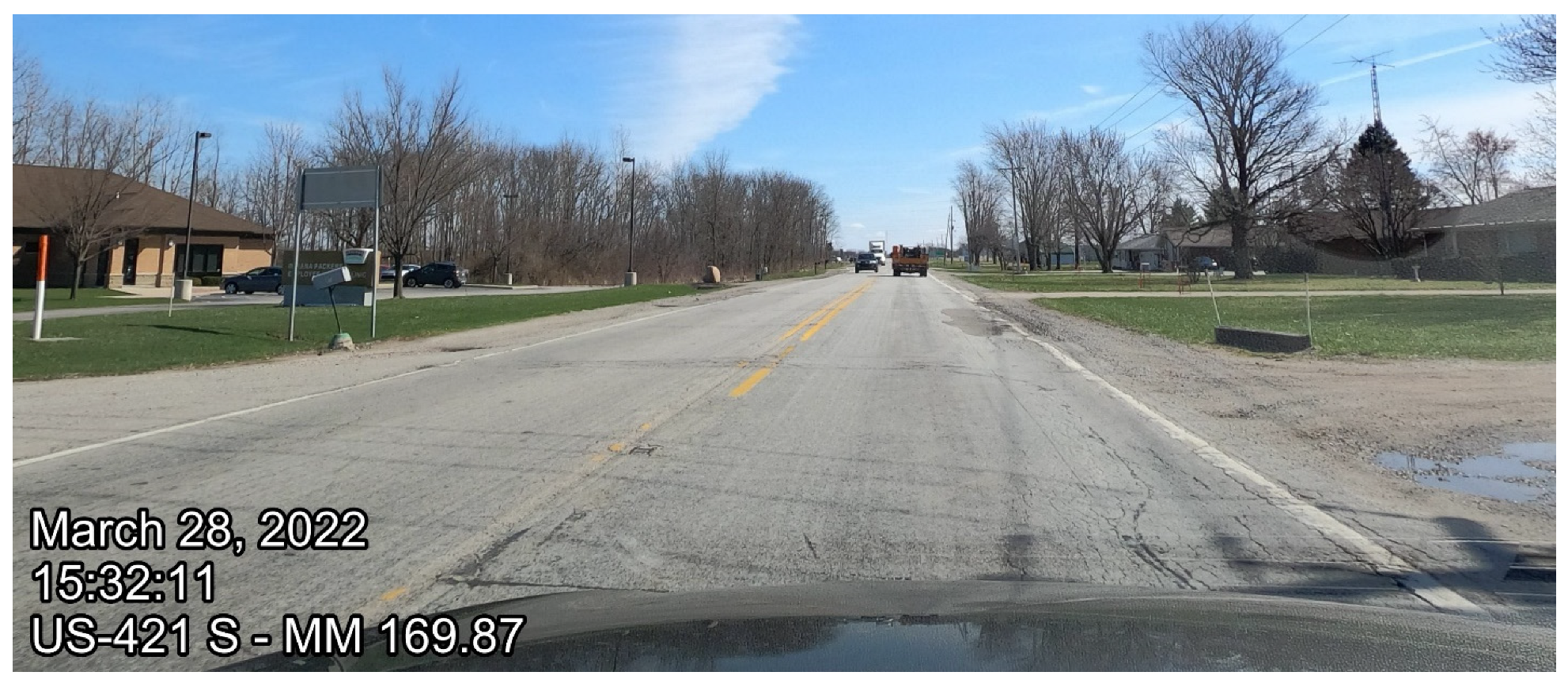
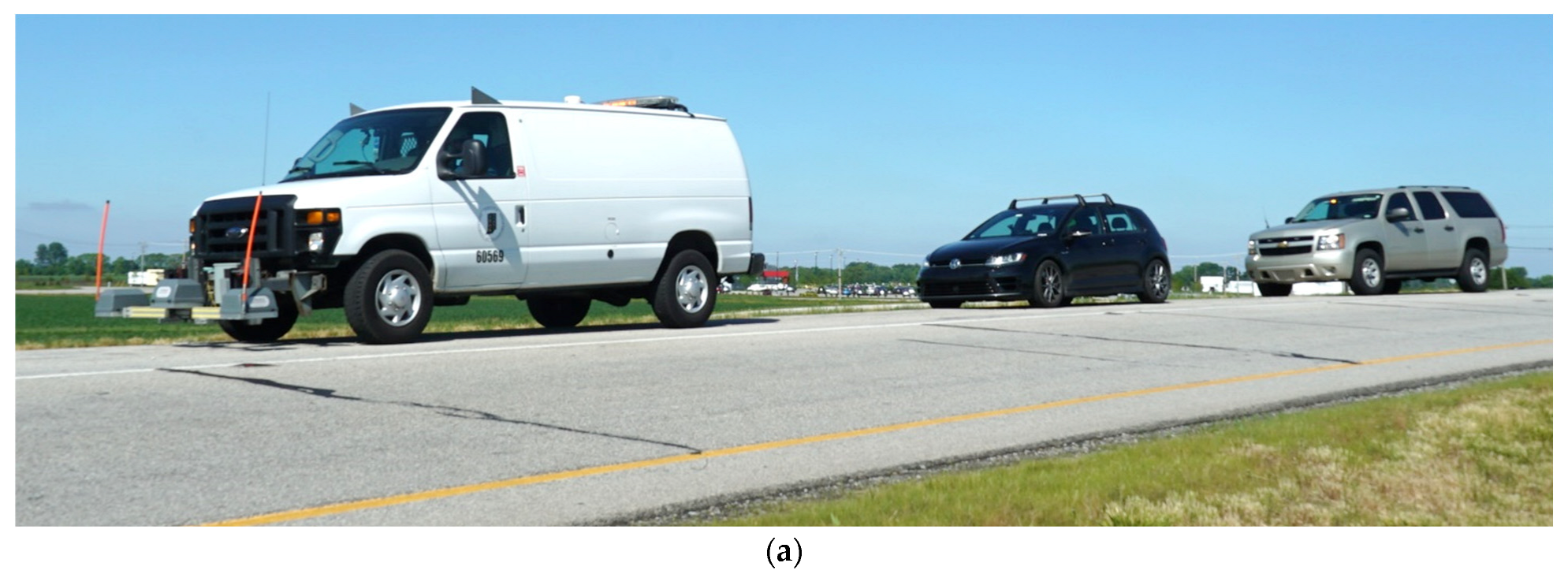

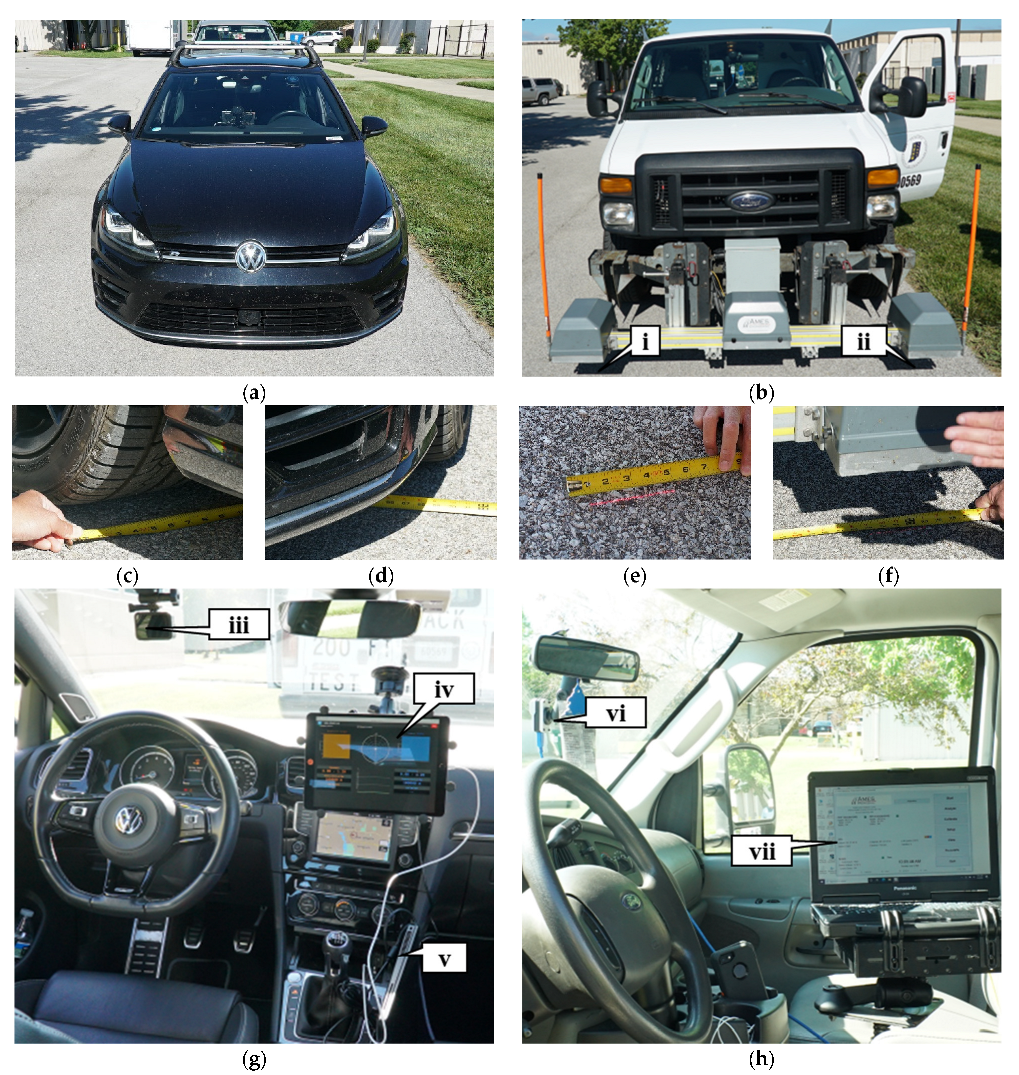
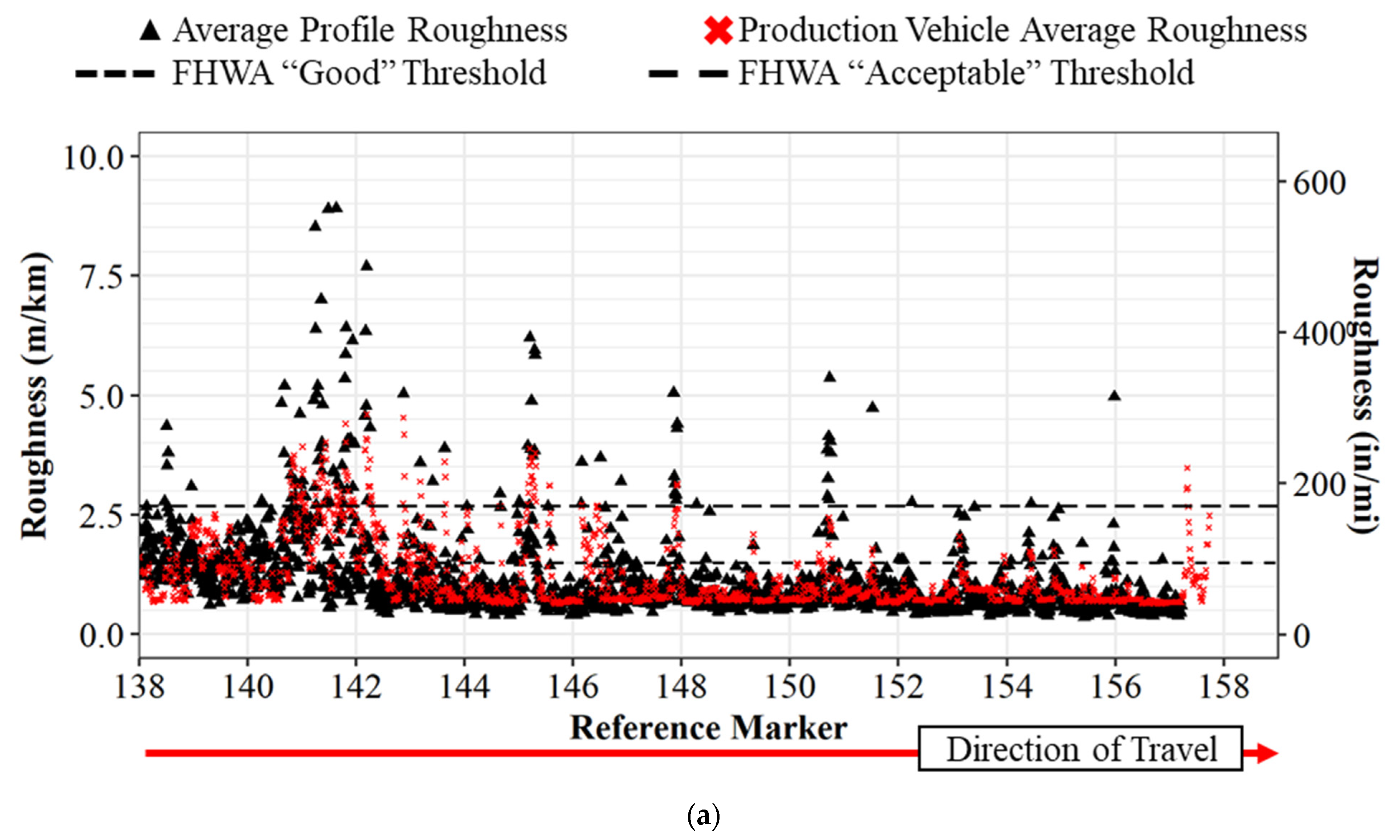

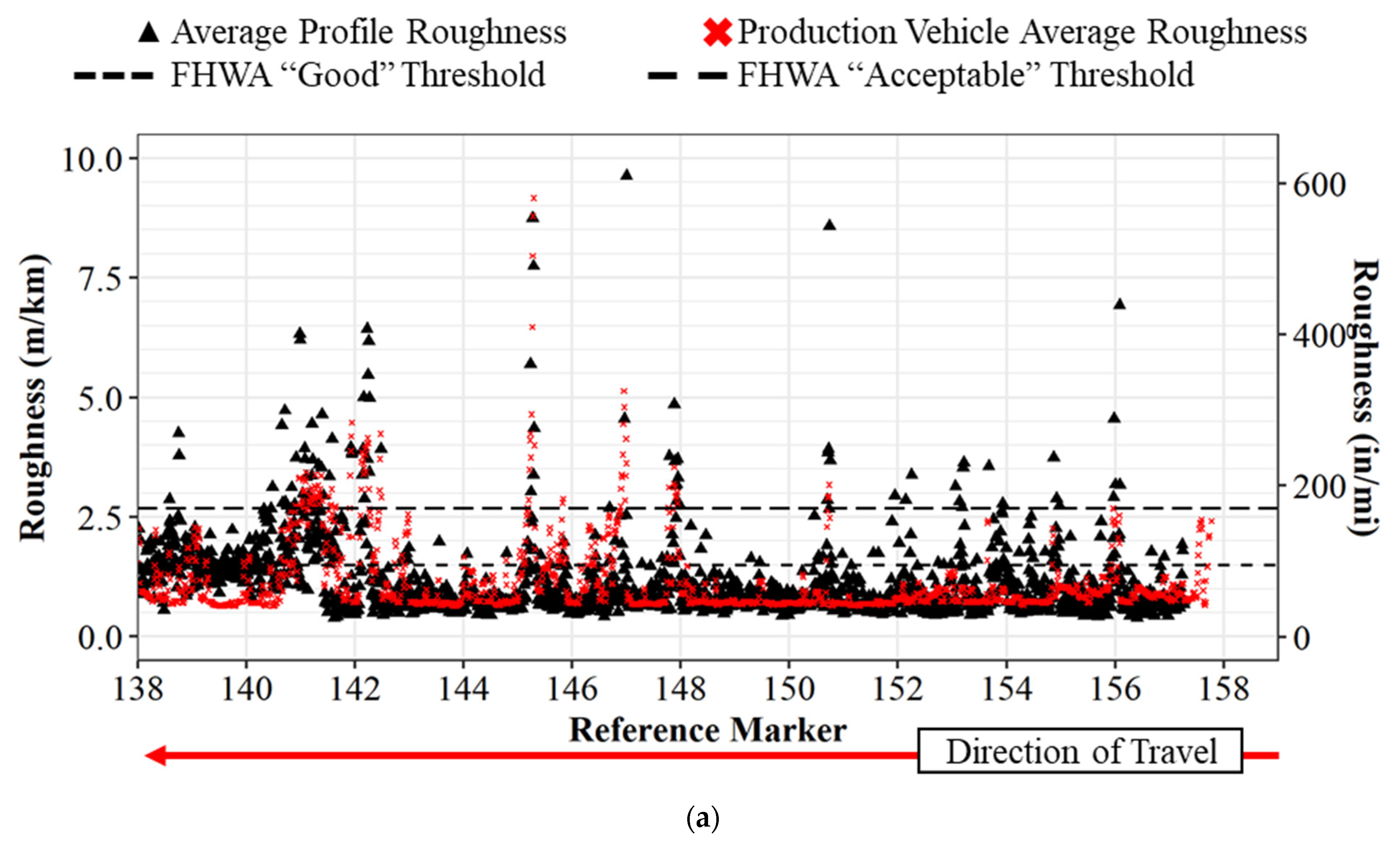


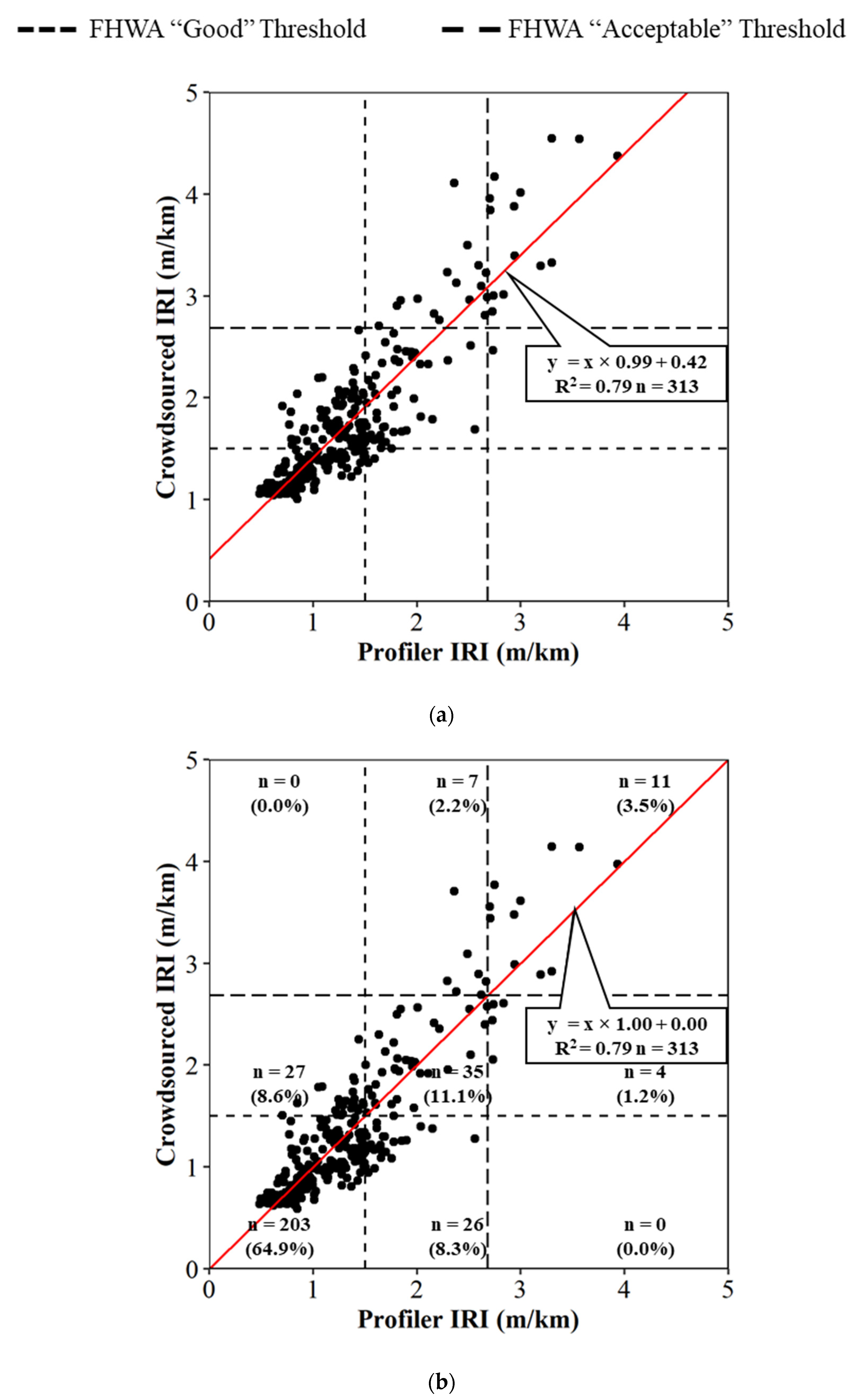

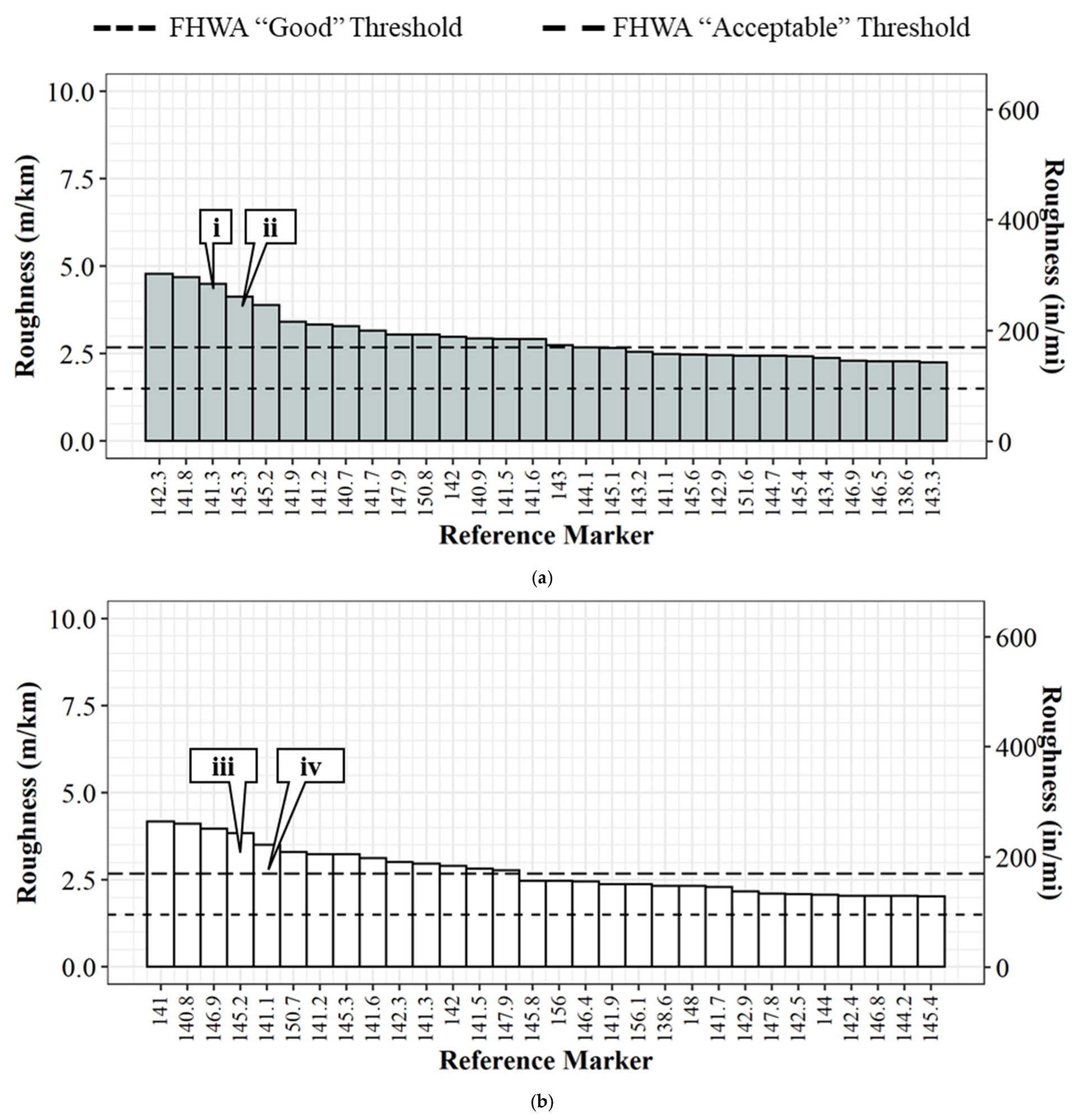

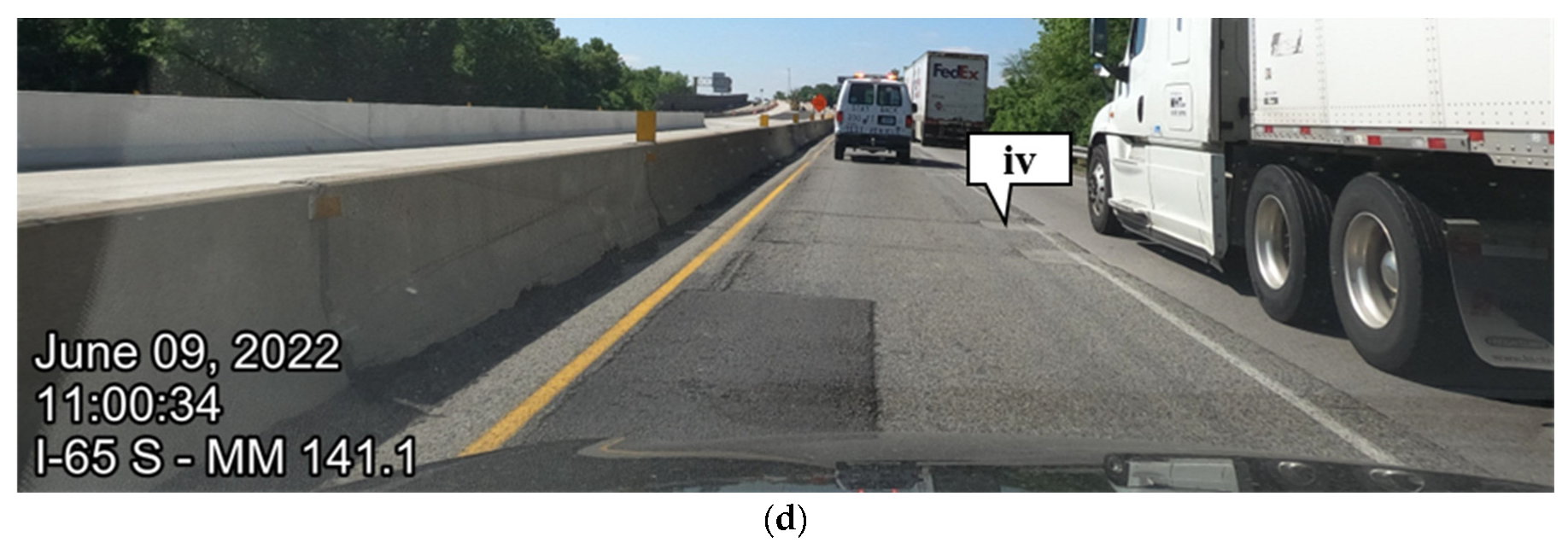
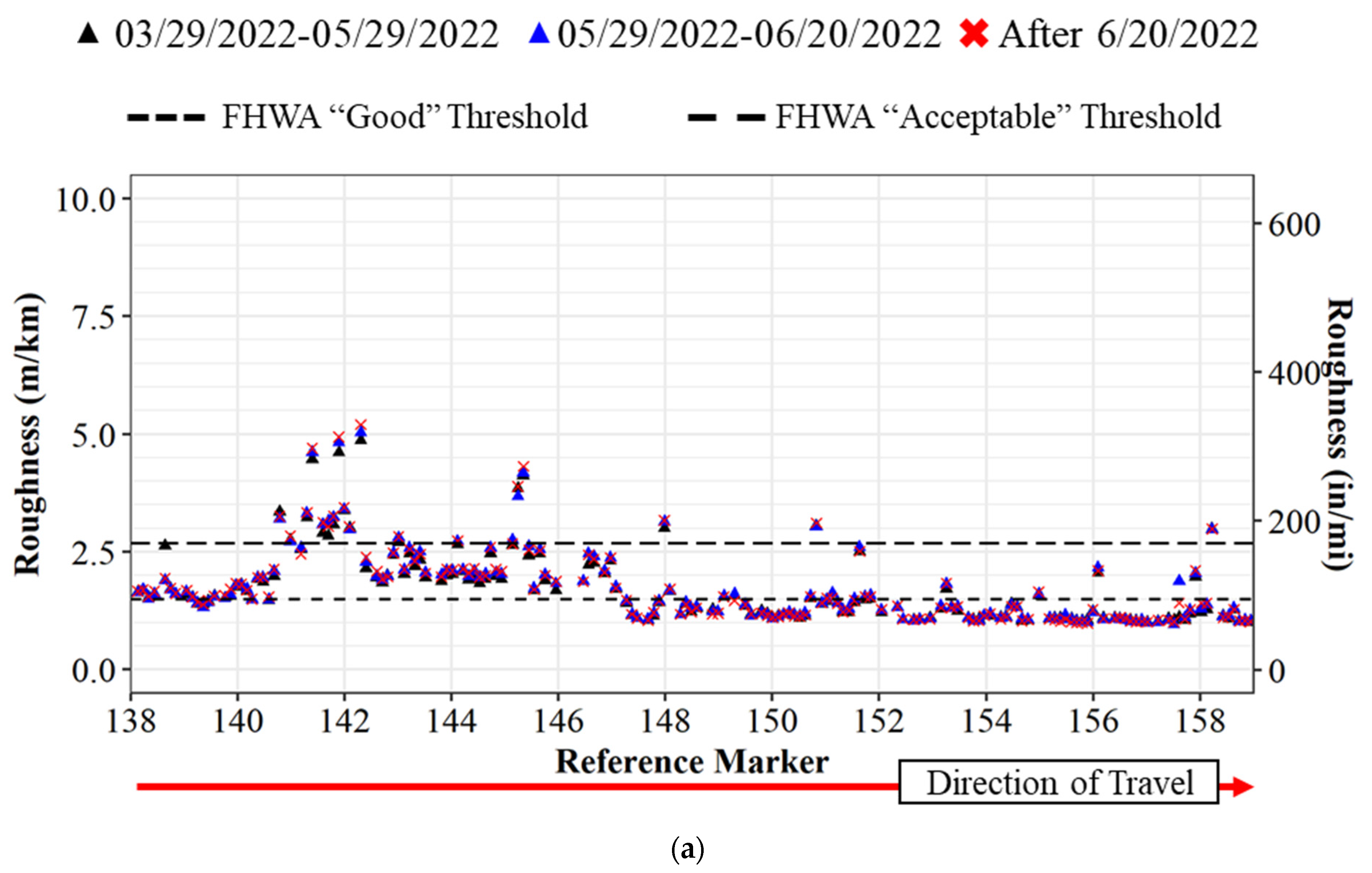



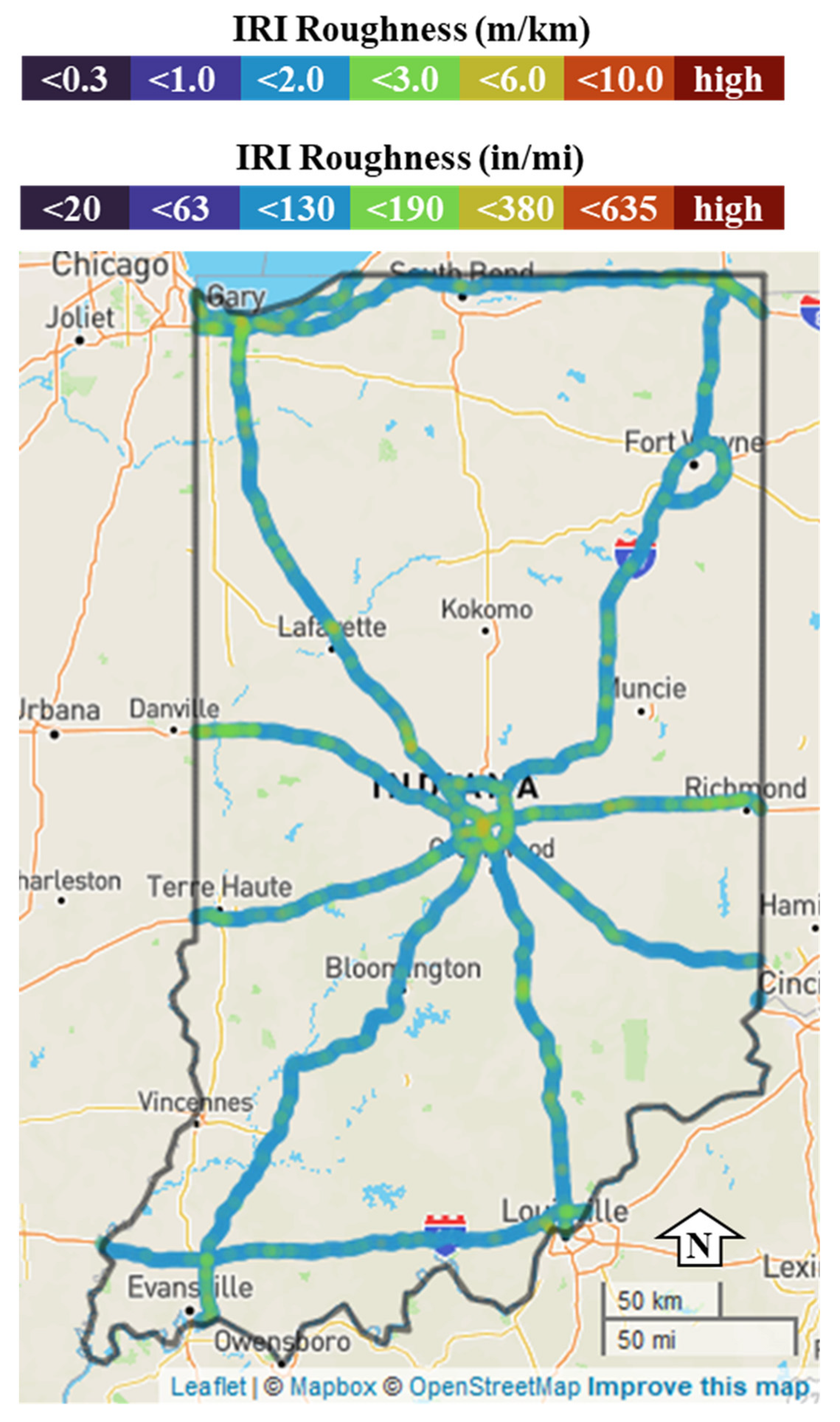
Publisher’s Note: MDPI stays neutral with regard to jurisdictional claims in published maps and institutional affiliations. |
© 2022 by the authors. Licensee MDPI, Basel, Switzerland. This article is an open access article distributed under the terms and conditions of the Creative Commons Attribution (CC BY) license (https://creativecommons.org/licenses/by/4.0/).
Share and Cite
Mahlberg, J.A.; Li, H.; Zachrisson, B.; Leslie, D.K.; Bullock, D.M. Pavement Quality Evaluation Using Connected Vehicle Data. Sensors 2022, 22, 9109. https://doi.org/10.3390/s22239109
Mahlberg JA, Li H, Zachrisson B, Leslie DK, Bullock DM. Pavement Quality Evaluation Using Connected Vehicle Data. Sensors. 2022; 22(23):9109. https://doi.org/10.3390/s22239109
Chicago/Turabian StyleMahlberg, Justin A., Howell Li, Björn Zachrisson, Dustin K. Leslie, and Darcy M. Bullock. 2022. "Pavement Quality Evaluation Using Connected Vehicle Data" Sensors 22, no. 23: 9109. https://doi.org/10.3390/s22239109




